#(◞龍. ┊ pictures.´ )
Explore tagged Tumblr posts
Text

『スサノオさん 捌』
絵描きの写真。( Pictures of painters. )
本日は辰の日なので素盞嗚神社の龍さんを☆
77 notes
·
View notes
Text
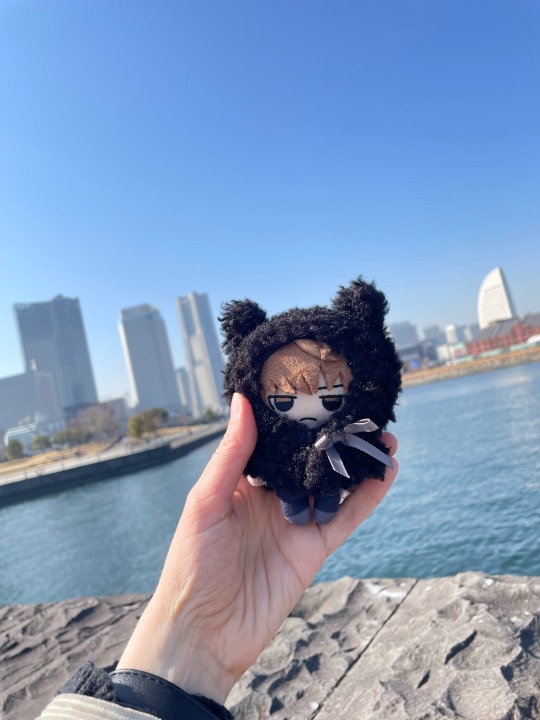
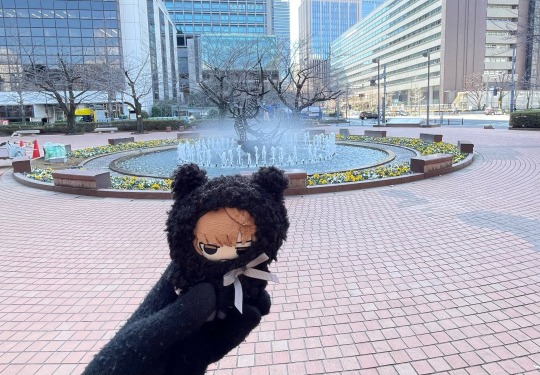
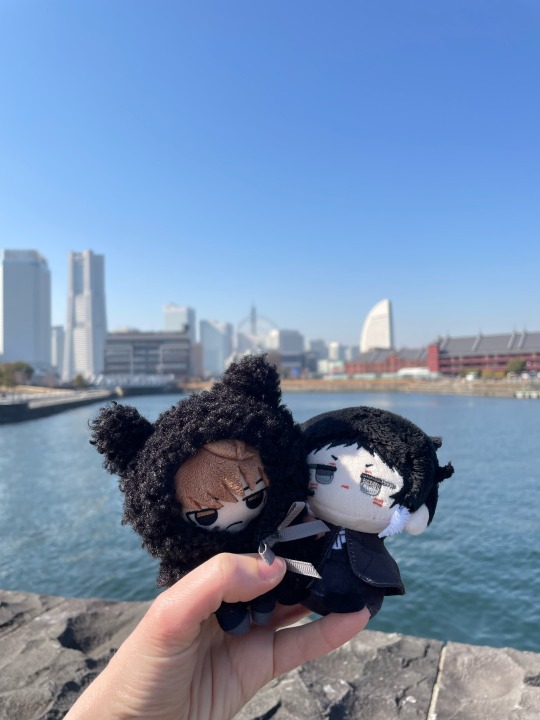

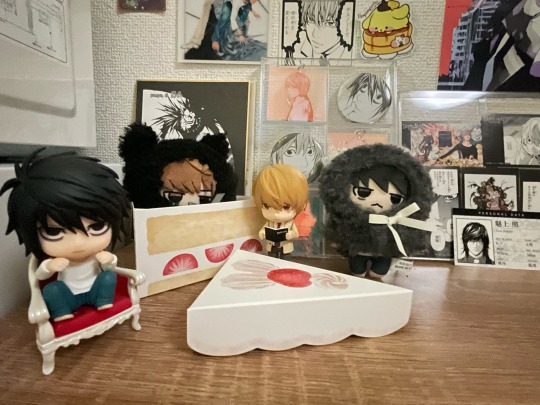
今日は月の誕生日だった。
お誕生日おめでとう🎂
そして、明日芥川の誕生日だ
happy birthday Light (ft. Akutagawa from bsd whose birthday is 1 March)
#death note#夜神月#light yagami#yagami light#l lawliet#lawlight#デスノート#bungou stray dogs#we went to Yokohama#also the one picture is from hibiya park#bungo stray dogs x deathnote?#mikami teru#teru mikami#amane misa#魅上 照#akutagawa ryuunosuke#芥川龍之介#文豪ストレイドッグス#文スト#ぬいぐるみ#yes light is wearing a calico critters hat i could not find any small hats and I already had it
49 notes
·
View notes
Text









I swear to god, if the male lead doesn't fall for her, I'd happily make her my wife.
source: Kowloon Generic Romance (九龍ジェネリックロマンス, Kūron Jenerikku Romansu) - Jun Mayuzuki
#moodboard#reiko#kujirai reiko#kowloon generic romance#aesthetic pfp#discord pfp#anime pfp#pfp#pfp icons#profile photo#anime#manga#manga pfp#pfp art#jun mayuzuki#九龍ジェネリックロマンス#city pop#profile pics#profile pic art#anime profile pictures#profile icons
82 notes
·
View notes
Text
I GOT THE FUNNY PETS DVD BOX SET TODAY- (the one with the picture book :3)
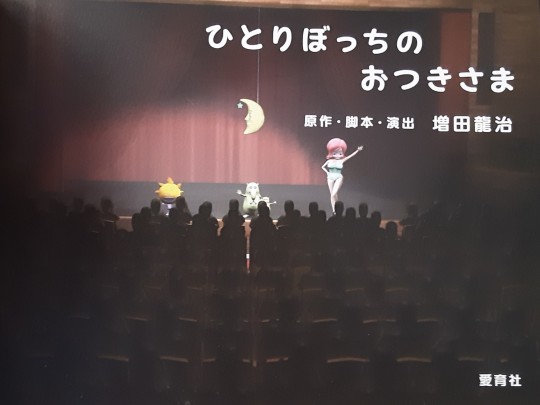
This was a stage performance?!
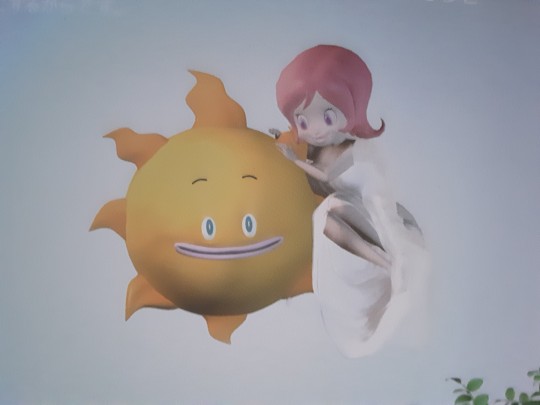
I LOVE WHATEVER FUNNY'S WEARING RN
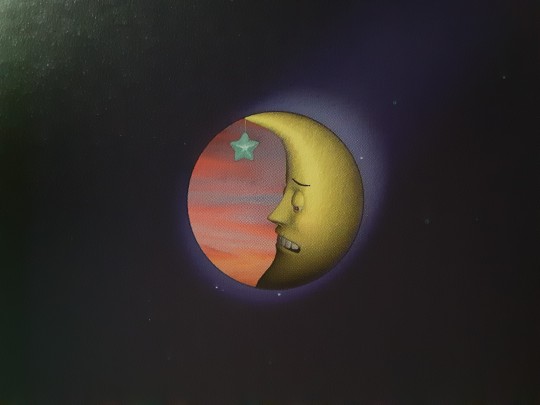
Sad boi :(
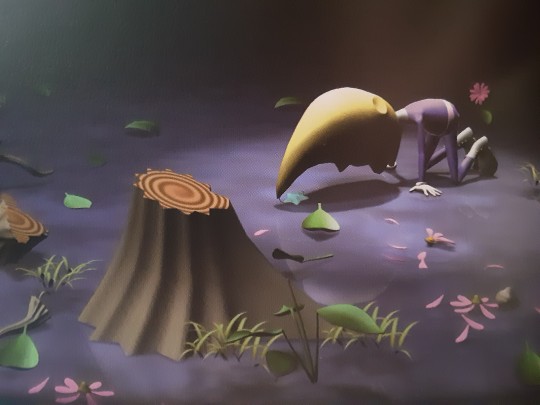
Another sad boi :(
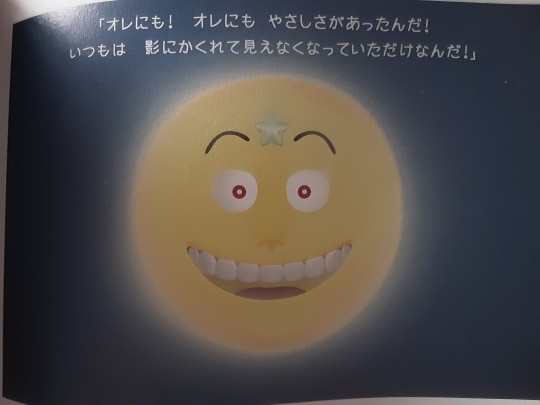
HOLY MOTHER OF GOD, IT'S A FULL MOON CRESCENT-
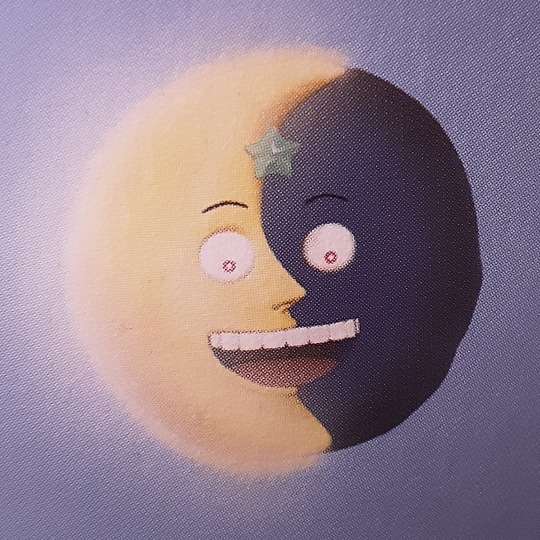
WTF-
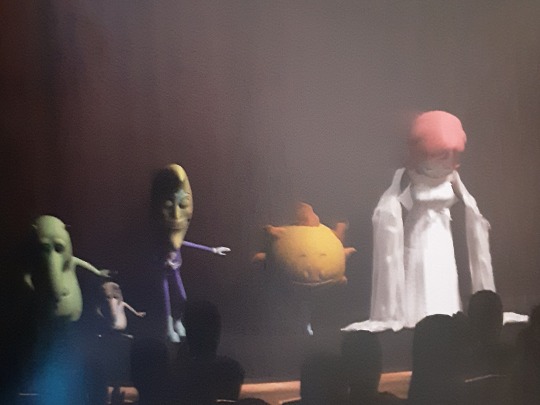
I STILL LOVE FUNNY'S DRESS BTW-
The book is short, so yeah.
Thanks for reading! Byeee :3
Update: STAIN'S HERE! AND HE'S A JANITOR!
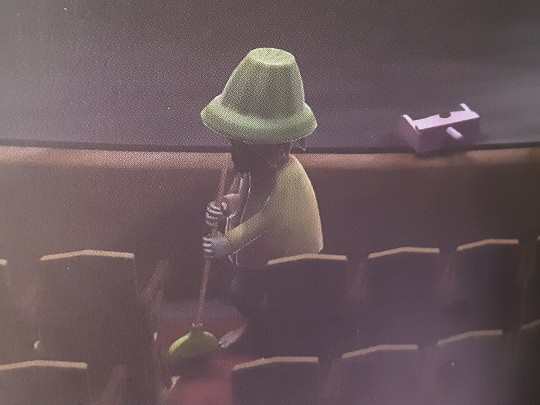
#funny pets show#corona funny pets#funny pets (anime)#crescent funny pets#funny pets anime#funny pets poetic and lunatic#masudaverse#wakako masuda#ryuji masuda#masudamedia#鼻血待機#増田作品#私の可愛さを思い知れ#増田若子#増田龍治#ファニーペッツ#picture books#picture book#book#ガラクタ 通 り の ステイン#mrstainonjunkalley#ga ra ku ta#mr. stain#mr. stain on junk alley#garakuta#garakuta doori no stain#ga ra ku ta: mr. stain on junk alley#garakuta: mr. stain on junk alley
23 notes
·
View notes
Text
The cover art of a cancelled picture book named "What Kind of Shape is it?" (2007)
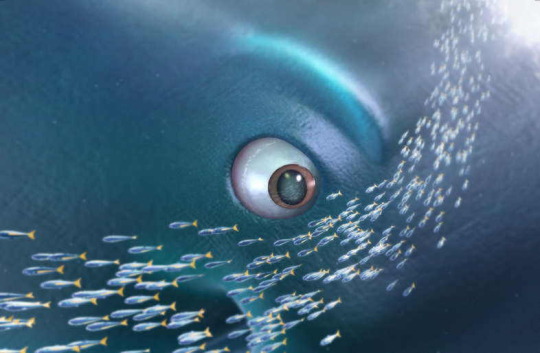
5 notes
·
View notes
Text






𝐌𝐀𝐑𝐀'𝐒 𝐂𝐀𝐌𝐄𝐑𝐀 𝐑𝐎𝐋𝐋 // 🚫
1. morning coffee with garam. / 2. notes at her police station office before a meeting. / 3. morning surprises to send to T Lio. / 4. noodles by herself on a thursday night. / 5. a late drive in itaewon. / 6. outfit check for the Black and White Swans party with chiwon.
#龍 : 𝐥𝐢𝐦 𝐦𝐚𝐫𝐚 / visuals.#She takes pictures of her casual every day#And a lot of pictures with her friends and favorites#Even if she isn't surrounded by many people she cherishes the most and cares about having their faces in her phone#They probably don't know that tho heh#龍 : 𝐥𝐢𝐦 𝐦𝐚𝐫𝐚 / the chameleon.
5 notes
·
View notes
Note
You have good taste when uploading images, or rather I like your taste when choosing them...
@visualthings66
Ⓢ Ⓤ Ⓟ Ⓔ Ⓡ \(。✪‿✪。) / Thanks! umm… good taste lol
and
😊 🎧 Hope that you'll like this Disney animated adventure film soundtrack 🦕
2024/1/19 Chu Lan~*
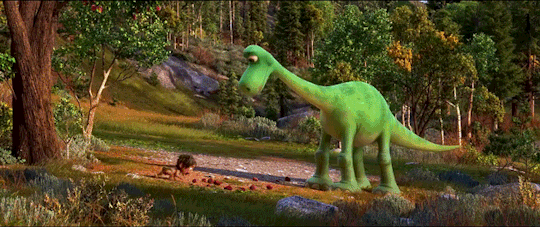
youtube
The Good Dinosaur (Original Motion Picture Soundtrack)
#answered#umm... good taste lol#dinosaur#好可愛#the good dinosaur 恐龍當家#mychael danna & jeff danna#homestead/soundtrack#the good dinosaur (original motion picture soundtrack)#i love dinosaurs 🦕#thank you 🙏
4 notes
·
View notes
Text
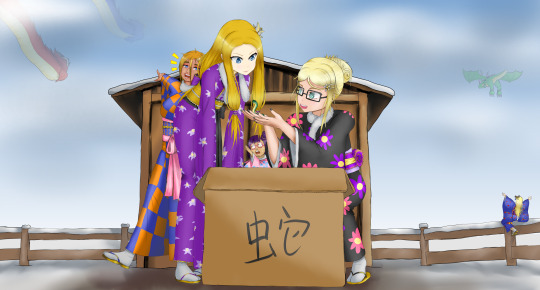
Year of the snek
I did that one in about 20 hours over this month. It's was nice to be able to spend time drawing for once, even if I still rushed it to post it this month.
#Drawing#Picture#New Year#Lunar New Year#Year of the Snake#Breath of Fire#Dragon's Dogma#Dragon#Ryû#Snake#Original Character#OC#絵#画像#旧正月#巳年#ブレスオブファイア#ドラゴンドグマ#龍#リュー#蛇#オリジナルキャラクター#オリキャラ#Valentine#ヴァランティン#Olga#オルガ#Emillie#エミリー#Leslie
0 notes
Note

If anyone's interested in reading the full text from the second screenshot, it's really fascinating because there are so many parallels you can draw between the dragon and the phoenix in Chinese mythology with Max and Charles' careers.
Also this picture? Incredibly appropriate 😂
Image source.
h-tt-p-s://twitter.com/mireia19980721/status/1783196373124591716?t=6tEIopIWffDtc0RR-Qjm2A&s=19
h-tt-p-s://twitter.com/maranellosaint/status/1783206647160017282?t=q4f0uw_KVISHcApVm6HGJQ&s=19
Well well well


Lestappen being compared to a cosmic marriage? Nothing new, really.
I do adore the symbolism of Max being the dragon though (majesty/water associated/blue) and Charles being the phoenix (rebirth/fire associated/red). The parallels keep coming, more proof of the universe being just a tiny bit weird with them.
#龍 max#鳳凰 charles#i absolutely love that this is a comparison that chinese fans/commentators have made#and they're so right!!#also i really can't believe how perfect this picture is#blue w red accents red bull dragon max#vs#red ferrari phoenix charles#lestappen#charles leclerc#max verstappen#chinese gp 2024#f1
453 notes
·
View notes
Text

『神社の龍神さん』
絵描きの写真。( Pictures of painters. )
今日はハロウィーン.....日本は辰年の辰の日◎
90 notes
·
View notes
Text









Relic Prohibited From Displaying Abroad: Northern Wei Dynasty Painting
Painted screen covered with vermilion lacquer from the tomb of Sima Jinlong (司馬金龍).
The outlines are finely drawn in black ink. A dazzling riot of colors distinguishes this specimen from those of previous centuries.
The painting illustrates narratives about female virtues and filial piety from Han dynasty Liu Xiang's (劉向) Confucian classic “Biography of Exemplary Women” (列女傳).
The top section from the well-preserved part in the photo depicts Emperor Shun's story of filial piety.
The second represents Three Queens of Zhou dynasty – Tai Jiang, Tai Ren and Tai Shi – exemplary mothers and wives (whose historicity remains in doubt) included in later collections of moral precepts.
The third section portrays Lushi Chunjiang and Chunjiang’s daughter.
The bottom one illustrates the episode when the Consort Ban (班婕妤) refused to accompany the emperor in a palanquin so as not to distract him from the thoughts about the state welfare.
The screen was unearthed in Shijiazhai (石家寨) village, Datong, Shanxi in 1965. It is surprising that many precious artifacts remained in the burial pit, despite repeated plundering. We can chalk it up to the ignorance of the thieves.
The board is 82 cm long, 40 cm wide and 2.5 cm thick. The two pieces of the lacquer-painted screen are connected by mortise and tenon joint.
Due to its exceptional fragility and value, the panel is not allowed to be exhibited abroad. Despite all the museum care, the second part of the diptych is not so well-preserved. The tomb has been repeatedly flooded over the centuries, and the dampness has taken its toll. The vermilion screen is stored in Datong Museum (大同市博物館), Shanxi. The original is rare on display for several days only, the rest of the time it is replaced by a replica. Pictured is the original.
#ancient china#chinese culture#chinese art#chinese history#chinese painting#painting miniatures#painting on wood#Northern Wei dynasty#lacquer#lacquerware#ancient tomb#tomb art#vermilion#artifact#unique#relic#han dynasty#burial site#burial#chinese customs
80 notes
·
View notes
Text
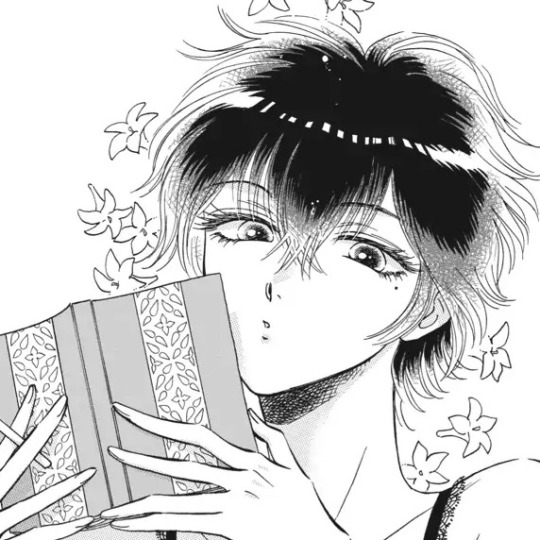
I'm surprised that she's totally normal.
source: Kowloon Generic Romance (九龍ジェネリックロマンス, Kūron Jenerikku Romansu) - Jun Mayuzuki
#jun mayuzuki#kowloon#kowloon generic romance#九龍ジェネリックロマンス#Kūron Jenerikku Romansu#Kujirai Reiko#Reiko#Kujirai Reiko Kowloon Generic Romance#aesthetic pfp#discord pfp#anime pfp#pfp#pfp icons#profile photo#anime#manga#manga pfp#pfp art#profile pics#profile pic art#profile icons#anime profile pictures#profile picture#profile images#romance#romance manga
11 notes
·
View notes
Text
[Hanfu · 漢服]Chinese Warring States period(475–221 BC) Traditional Clothing Hanfu-Life of Qu Yuan(屈原)
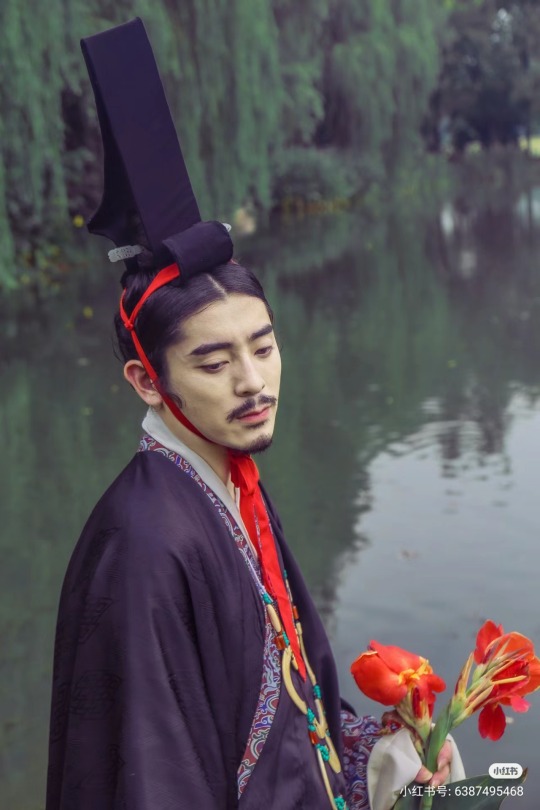
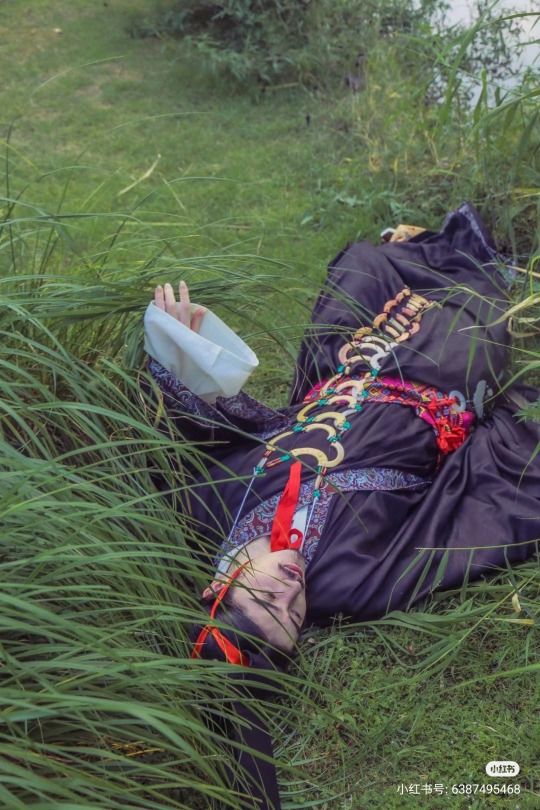
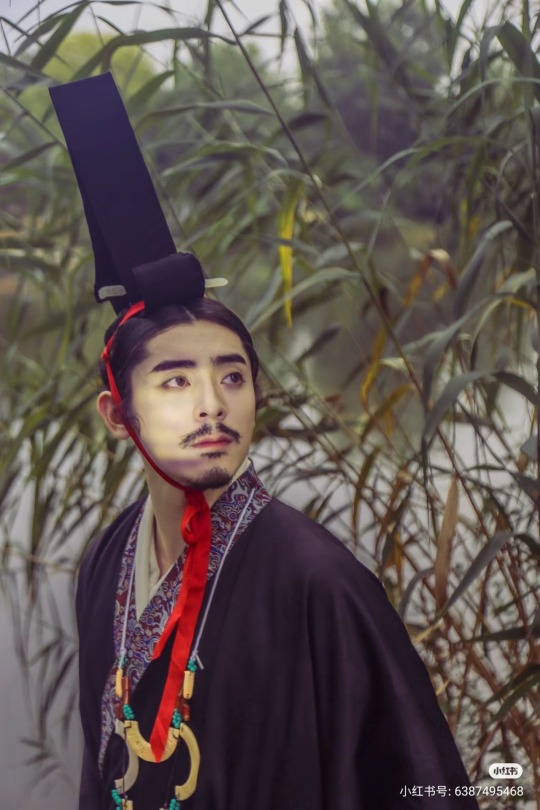
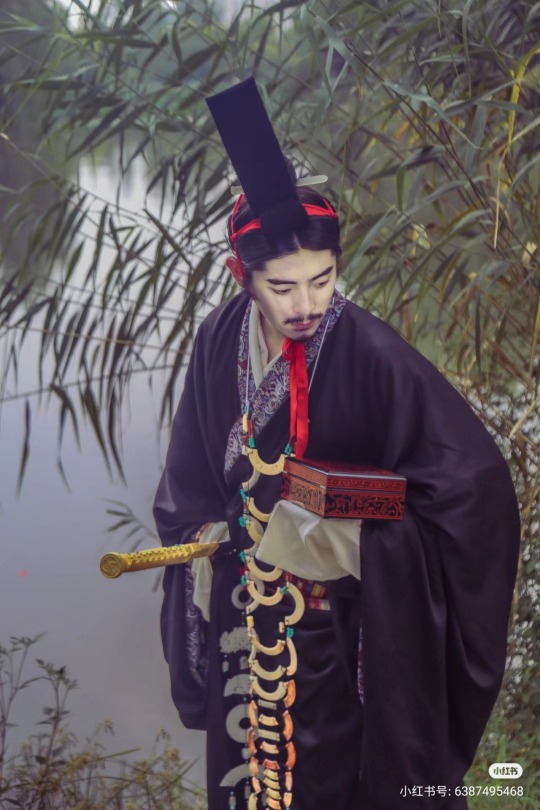
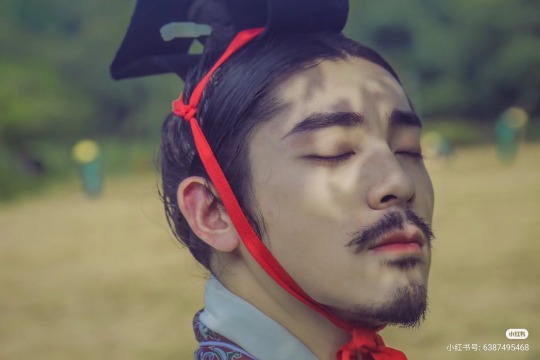
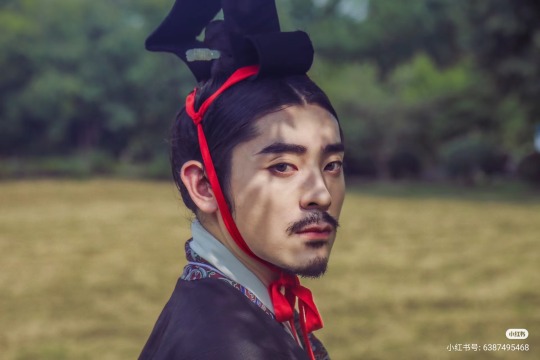
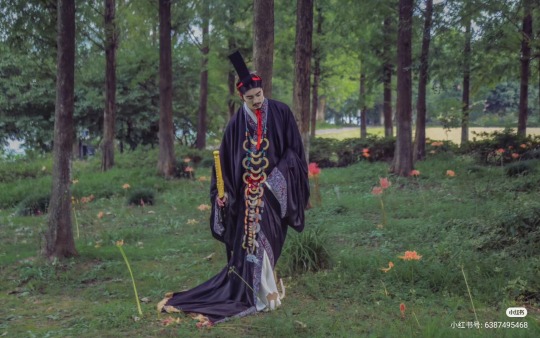
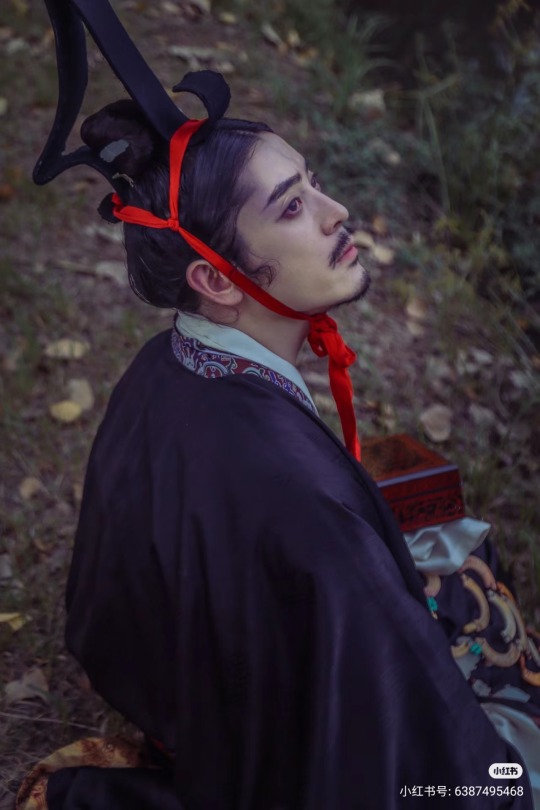
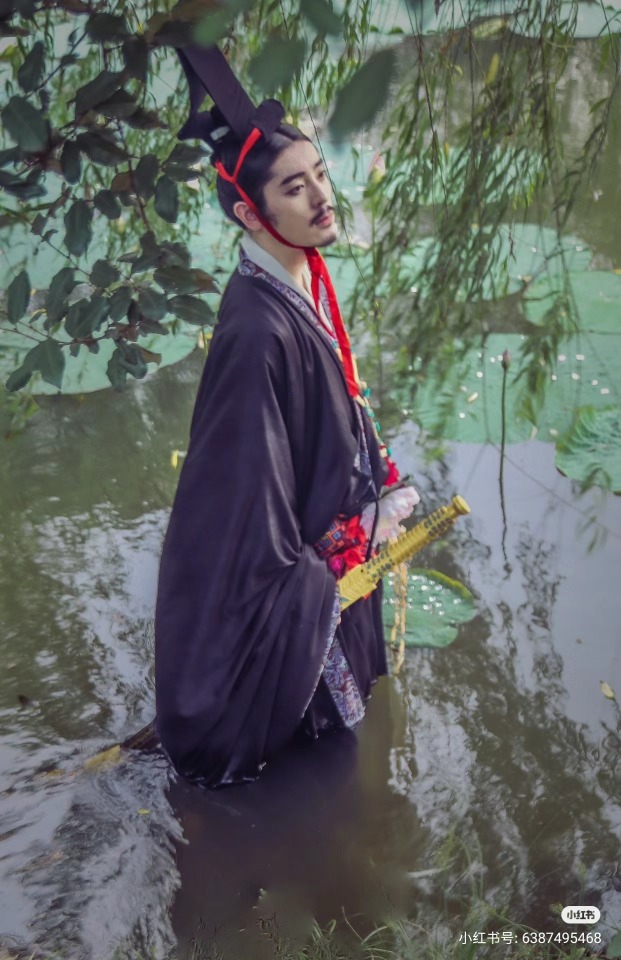
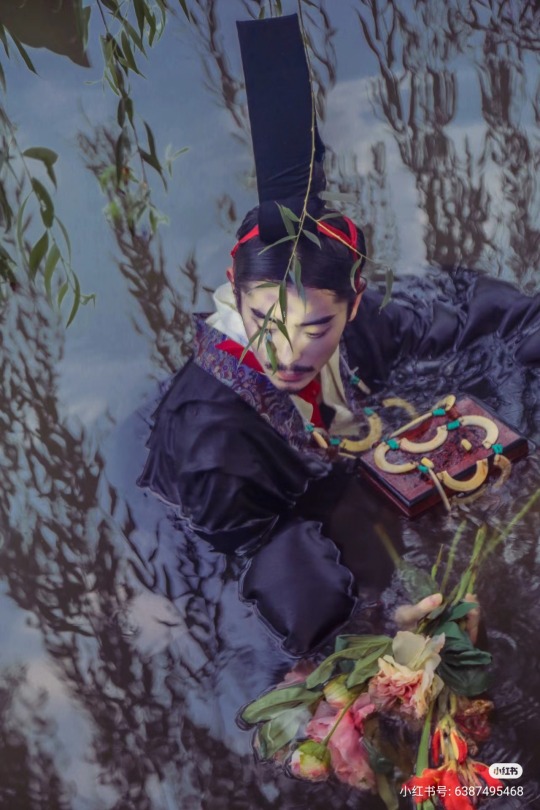
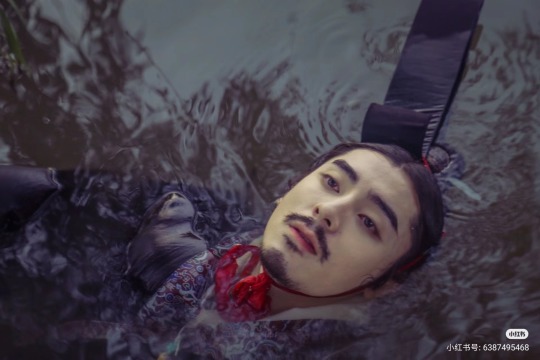
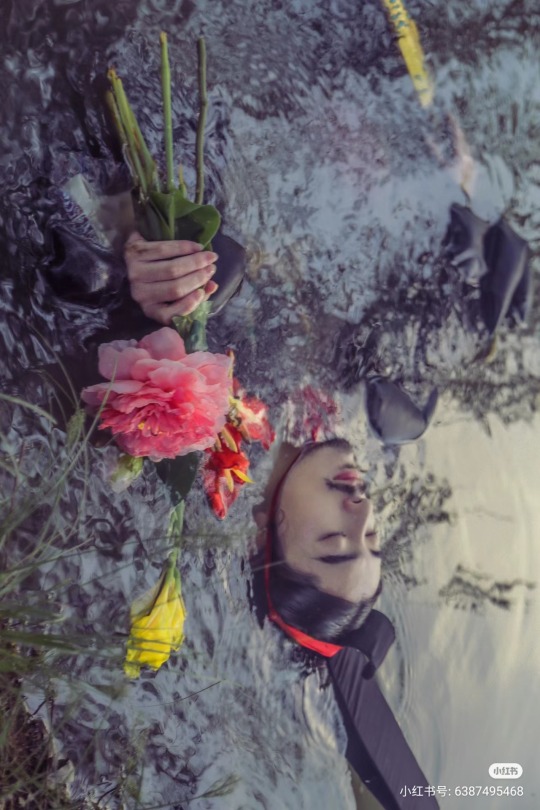
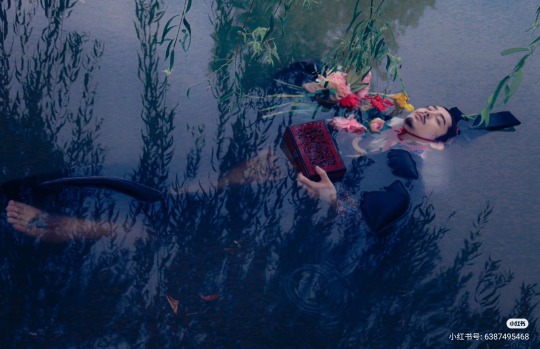
【Historical Artifact Reference】:
China Warring States period (475-221 BC):Silk painting depicting a man riding a dragon (人物御龍帛畫)
it was discovered in the Zidanku Tomb no. 1 in Changsha, Hunan Province in 1973. Now in the Hunan Museum
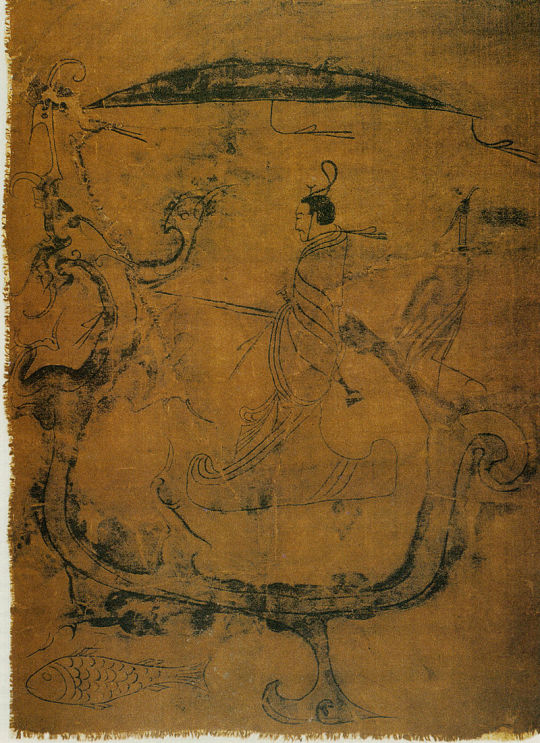
A man with a sword is riding a dragon by holding the rein. The dragon's body was given the shape of a boat. A little egret is standing at the tail of the dragon. A carp under the dragon is leading the way. The umbrella in the top middle of the picture shows the owner's nobility. The work has become associated with the Chu poet Qu Yuan’s famous verse from his poem Shejiang (涉江, Setting foot in the river), ‘Carrying a long sword with weird colour; Wearing a qieyun–styled high cap.” (帶長鋏之陸離兮, 冠切雲之崔嵬)
Western Zhou Dynasty seven-huang jade pendant with linked beads/西周七璜联珠组玉佩

About Qu Yuan(屈原)
Qu Yuan (c. 340 BC – 278 BC)was a Chinese poet and aristocrat in the State of Chu during the Warring States period. He is known for his patriotism and contributions to classical poetry and verses, especially through the poems of the Chu Ci anthology (also known as The Songs of the South or Songs of Chu): a volume of poems attributed to or considered to be inspired by his verse writing. Together with the Shi Jing, the Chu Ci is one of the two greatest collections of ancient Chinese verse. He is also remembered in connection to the supposed origin of the Dragon Boat Festival.
Historical details about Qu Yuan's life are few, and his authorship of many Chu Ci poems has been questioned at length.[4] However, he is widely accepted to have written "The Lament," a Chu Ci poem. The first known reference to Qu Yuan appears in a poem written in 174 BC by Jia Yi, an official from Luoyang who was slandered by jealous officials and banished to Changsha by Emperor Wen of Han. While traveling, he wrote a poem describing the similar fate of a previous "Qu Yuan."Eighty years later, the first known biography of Qu Yuan's life appeared in Han dynasty historian Sima Qian's Records of the Grand Historian, though it contains a number of contradictory details.
Life of Qu Yuan(屈原)
The only surviving source of information on Qu Yuan's life is Sima Qian's biography of him in Records of the Grand Historian (Shiji), although the biography is circumstantial and probably influenced greatly by Sima's own identification with Qu.Sima wrote that Qu was a member of the Chu royal clan and served as an official under King Huai of Chu (reigned 328–299 BC).
During the early days of King Huai's reign, Qu Yuan was serving the State of Chu as its Left Minister. However, King Huai exiled Qu Yuan to the region north of the Han River, because corrupt ministers slandered him and influenced the king.Eventually, Qu Yuan was reinstated and sent on a diplomatic mission to the State of Qi. He tried to resume relations between Chu and Qi, which King Huai had broken under the false pretense of King Hui of Qin to cede territory near Shangyu.
During King Qingxiang's reign, Prime Minister Zilan slandered Qu Yuan.[9] This caused Qu Yuan's exile to the regions south of the Yangtze River. It is said that Qu Yuan returned first to his home town. In his exile, he spent much of this time collecting legends and rearranging folk odes while traveling the countryside. Furthermore, he wrote some of the greatest poetry in Chinese literature and expressed deep concerns about his state. According to legend, his anxiety brought him to an increasingly troubled state of health. During his depression, he would often take walks near a certain well to look upon his thin and gaunt reflection in the water. This well became known as the "Face Reflection Well." On a hillside in Xiangluping (at present-day Zigui County, Hubei Province), there is a well that is considered to be the original well from the time of Qu Yuan.
In 278 BC, learning of the capture of his country's capital, Ying, by General Bai Qi of the state of Qin, Qu Yuan is said to have collected folktales and written the lengthy poem of lamentation called "Lament for Ying". Eventually, he committed suicide by wading into the Miluo River in today's Hunan Province while holding a rock. The reason why he took his life remained controversial and was argued by Chinese scholars for centuries. Typical explanations including martyrdom for his deeply beloved but falling motherland, which was suggested by the philosopher Zhu Xi of the Song dynasty, or feeling extreme despair to the situation of the politics in Chu while his lifelong political dream would never be realized. But according to "Yu Fu," widely considered to be written by Qu himself or at least, a person who was very familiar with Qu, his suicide was an ultimate way to protect his innocence and life principles.[citation needed]
Qu Yuan is said to have expressed his love for the ruling monarch, King Huai of Chu, through several of this works, including "The Lament" and "Longing for Beauty".
Dragon Boat Festival/端午节
Popular legend has it that villagers carried their dumplings and boats to the middle of the river and desperately tried to save Qu Yuan after he immersed himself in the Miluo but were too late to do so. However, in order to keep fish and evil spirits away from his body, they beat drums and splashed the water with their paddles, and they also threw rice into the water both as a food offering to Qu Yuan's spirit and also to distract the fish away from his body. However, the legend continues, that late one night, the spirit of Qu Yuan appeared before his friends and told them that he died because he had taken himself under the river. Then, he asked his friends to wrap their rice into three-cornered silk packages to ward off the dragon.
These packages became a traditional food known as zongzi, although the lumps of rice are now wrapped in leaves instead of silk. The act of racing to search for his body in boats gradually became the cultural tradition of dragon boat racing, held on the anniversary of his death every year. Today, people still eat zongzi and participate in dragon boat races to commemorate Qu Yuan's sacrifice on the fifth day of the fifth month of the traditional lunisolar Chinese calendar.
--------
Recreation Work by : @晴南
Xiaohongshu🔗:http://xhslink.com/CU2x9J
--------
#chinese hanfu#Warring States period(475–221 BC)#Qu Yuan(屈原)#State of Chu#china history#chines history#hanfu#hanfu accessories#hanfu_challenge#chinese traditional clothing#china#chinese#chinese aesthetics#chinese historical fashio#漢服#汉服#中華風#晴南#Dragon Boat Festival/端午节
187 notes
·
View notes
Note
Shino-san, you made a post on X and Bluesky about a group you made on mixi and posted a lineart picture of Chunosuke and Nyasogi to accompany it. Can I use the lineart picture to practice my embroidery?
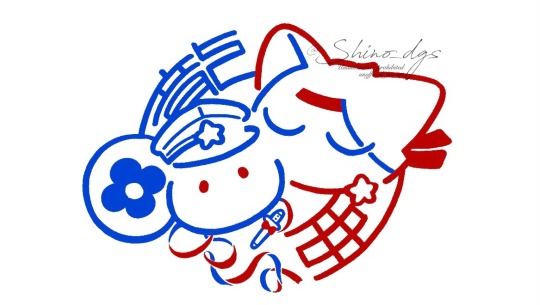
Thank you for your message, is this the picture here?
Please use it as long as it is for your personal enjoyment and not for sale!☺️
43 notes
·
View notes
Text
More images from the Mr. Stain book X3

Is this a Popee reference? (I know it's raining wine, but it looked like blood to me)
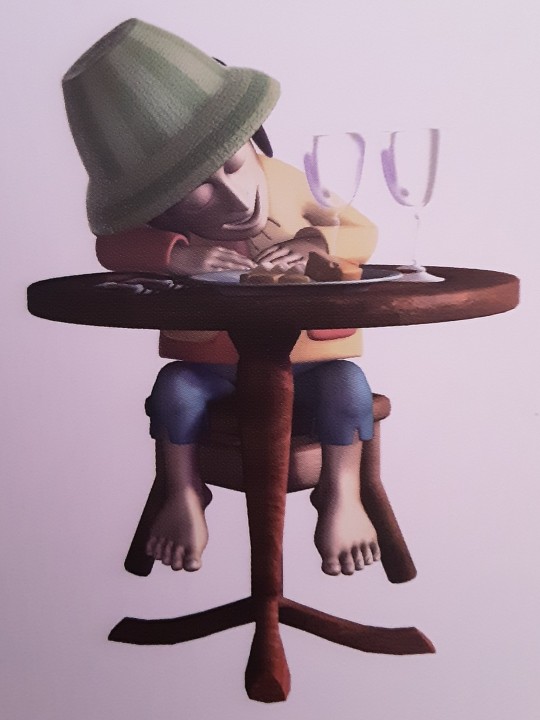
He sleepy X3

Goober
I guess that's it from me! Bye!
#mr stain on junk alley#mrstainonjunkalley#mr stain#mrstain#ga ra ku ta#mr. stain#ガラクタ 通 り の ステイン#popee the ぱフォーマー#ptp popee#popee the clown#popee the performer#ポピーザぱフォーマー#mr. stain on junk alley#ga ra ku ta: mr. stain on junk alley#garakuta#garakutadoorinostain#garakuta doori no stain#masudamedia#ryuji masuda#masudaverse#wakako masuda#増田龍治#増田若子#picture book#book#book media#popee#popeetheperformer#garakuta: mr. stain on junk alley#popeetheclown
8 notes
·
View notes
Text
I dunno where I'm going with all this but let's just go down a little checklist of fairly distinct Chinese style elements present in Bleach that kind of don't get addressed in the big picture?

The first and most obvious one is that when Madarame Ikkaku first shows up with his bald head and bladed polearm, which is a kind of unorthodox mix of a Japanse naginata (as an extension of standard zanpakutou being katanas) and a Chinese spear, Qiāng[槍] particularly with the iconic red horsehair tassle, although weirdly kubo puts it on the wrong side? And this is further played upon when it's revealed to actually be a bladed Sānjié-gùn[三節棍], a three-section staff but aka Pánlóng-gùn[蟠龍棍]: "CoiledDragon Staff".
He has very clear shaolin monk vibes going for him. Although due to what I chalk up to more a limitation of Kubo's knowledge/art style, Ikkaku's fighting style doesn't actually resemble any recognizable wushu spear or staff forms that you might expect from either old martial arts movies or contemporary sport performances.

And that all is further supplemented by his eventual bankai reveal, which not only adds a few more vaguely wushu adjacent weapon shapes but also corrects the horsehair tassle problem, putting them on the right side of the weapon; under the blade. The oversized glaive-like blade in the context of Chinese martial arts theme points toward the iconic Guandao, a weapon said to have origianlly been custom made for the legendary general of the Three kingdoms era, Guan Yu[關羽], hence the name Guan-dao[關刀]: "Guan (broad)sword/sabre."
This original mythical weapon was named Qīnglóng Yǎnyuè-dāo[靑龍偃月刀], the "GreenDragon LyingDown-Moon (broad)Sword." The irony and perhaps mythic drama of the name being that it's not a broad sword at all, it's a polearm, implying a kind of mythical stature and/or strength of the historical Guan Yu that he could weild this massive two handed weapon as if it were a one handed sword. But also more literally it is just a dao broadsword on a polearm, unlike what would otherwise have been the much smaller head of any other contemporary polearm weapon.
The opposite end has what appears to be a more identifiably pulled from what's generally called a "monk's spade" in english, but the chinese name Yuèyá-chǎn[月牙鏟] literally means "CrescentMoon-Shovel."

Another pretty clear set of references are centered around Sui-feng. her names are all Chinese (Shāolíng[梢綾], Fēng[蜂], and Suìfēng[碎蜂]) And I went into an old kind of lopsided theory ages ago, but there used to be a pretty common practice in China of giving children, especially boys, a "milk name" when they were born --which would be a kind of place holder fulfilling some superstitious needs-- and then replaced as the child grew older. Bruce Lee's milk name was Xì Fèng[細鳳], which was a girl's name that, according to the superstitions around the practice, was meant to misdirect misfortune and evil spirits from targeting a family's first son. And the phonetics of Xì-Fèng and Suì-fēng, atleast in Japanese, are remarkably close. That all is in conjunction with her obvious kung fu theming and the fact that her hornet themed sword seems to also play off of the iconic yellow with black stripes jumpsuit that Bruce Lee wears in his final film, Game of Death.
In addition her two-strike "instant" kill power seems to be a nod to the old kungfu myth/cliche of a kind of hybrid martial arts-acupuncture technique(s) that can do things like block blood or energy flow, disable limbs, or stop the heart directly via exploitations of precise pressure points.
Honestly it's kind of weird that there's more, like, blondes running around than Chinese people in Soul Society... Oh, but speaking of...

It's definitely not the most direct reference, but Kira's Wabisuke has a unique hook shape that really only has one parallel in real world weapons, and that's the Chinese hook swords. But those are traditionally used in a pair, not alone, and have a more curved shape than Wabisuke's rigid right angles, so it's very probably just kind of coincidence.
On a similar note though, Hisagi's Kazeshini also resemble, at least superficially, a set of Chinese weapons called Jī zhuǎ lián[雞爪鐮]: "chicken claw sickles." A more obvious comparison might be made to kama, as they are small single hand scythes with more Okinawan origins and are commonly either used in pairs or attached to a chain(although not typically to a second scythe but to a counter weight/bullet), but notably the chicken claws do have a second blade on the back end as well as a spike, which are notably not present on any kama. Again though it's also possible that Kubo just wanted wacky fantasy scythes and there's only so many combinations of sharp things on a stick you can really make...

Moving right along there's actually a quite a few little nods to Chinese styles in the Arrancar. The first and most obvious was Shawlong Koufang[シャウロン・クーファン] who's got a clearly Chinese name, even though Kubo chose to give it some funky romanization. It's probably meant to evoke Xiǎolóng[小龍] meaning "little dragon" which might be meant to read as a kind of epithet for a long narrow bug like the earwig his sword is named after. His hair style is also clearly meant to evoke the cue hairstyle typical of qing dynasty period dramas. His straight back, hands behind the back posture, cool demeanor and neatly zipped up collar and long coat tail is also very evocative of a certain character type in old kung fu films; the very calm and controlled master with very minimal movements casually sidestepping attacks and countering with sharp efficient snappy movements.
And while I don't know that I'd otherwise have pegged him as a specifically Chinese kind of caricature, something about the proximity to Shawlong does make me think Nakeem Grindina counts as well, even though his name is not nearly as evocative. We barely got to see anything form him, which doesn't help pinpoint him by way of characterization, but he does feel kind of reminiscent of a young Sammo Hung; famous martial arts actor who came up right along side the likes of Jackie Chan in the 70s and 80s. He's notably got a huskier body type not typically found in kung fu films.

There's also Choe Neng Poww[チーノン・ポウ] who, like Shawlong, has a weirdly romanized name but that retains a vaguely chinese phonetic quality to it; I frequently forget that the actual Japanized Chinese phonetics are "CHII NON' POU" which just isn't remotely reflected in the romanization, even within the fucked up bounds of how messy romanizing Chinese is. Anyway, he doesn't really appear to be based on anyone or anything in particular, but he is drawn with features very common in historical cases of Chinese men with medical gigantism, with the long face and square jaw, of whom there are several. Oh he does have a kind of chinese style outfit, complete with little Chinese slipper/kung fu shoe lookin things.
(I used a picture of Zhan Shichai largely just because he's an old enough case to have toured around the world as an oddity when there was still a pretty rigid different in ethnic fashions --like, half the other cases of gigantism in China are in the past 50 years so the photos of just of like a guy in a shirt and slacks.)
And then there's Ggio Vega, who, like Nakeem, definitely doesn't appear to have a Chinese name at all, yet his outfit and style are very distinctly kung fu film inspired. Like Shawlong he's got the cue braid, and that particular era of cheongshan that I don't really know how to place... It vanished after the communist revolution, but I don't know how far back it goes or when it was most recognizable? (I associate it with the Republic Era(early 1900s) in historical dramas, but I don't know if that's accurate?)

Anyway... Cyan Sung-sun also has a super China-girl sort of aesthetic going for her. A very classically petite and demure, elegant but kind of haughty look and feel. It's kind of adjacent to the Yamato-Nadeshiko or hime character types, but different? The long sleeves also feel very specific to something that I can't quite put my finger on.... Plus as I've mentioned before her resurreccion seems to be a direct nod to the classic Chinese myth of the "Madam White Snake."
Oh but circling back for Aaroniero, but technically Kaien, I forgot his Nejibana is actually a type of "double halberd" called a Shuāng jǐ[雙戟] but Kubo clearly wanted it to evoke a trident. Of note there are a variety of Chinese style tridents and pronged polearms, but this isn't one of them. The halberd specifically has a blade on one or both sides, rather than stabbing prongs. But what pegs it as a Chinese weapon is again the distinctive horsehair tassels.

And then of course we've got Cang Du[蒼都] who is actually the only other character that Kubo gave a proper Chinese name like he did Sui-Feng. Despite how Kubo romanized it, the Japanese phonetics are actually SHI-A-N' TU[シァン・トゥ]. He sports a much more pre-western style of old wushu attire but of course with the extra quincy flair, including a neat pair of metal tipped kung fu shoes.
He also has his one off little snake fang attack, despite not seeming to have any other snake motif... It doesn't have a specific style to it, but given the proximity to the whole wushu thing, it seems like a loose reference to 5-animal style kung fu's snake-style. Moreover, his Schrift being the Iron, in the context of his martial arts thing, seems to be a play on Iron Shirt kung fu, which is that one set of stunts you often see shaolin monks performing where they seemingly resist all damage to themselves under impossible looking circumstances.
Oddly of all the things going on with him, the wolverine claws aren't really any kind of a traditional Chinese martial arts weapon at all. They really seem to have more in common with Japanese ninja cliches, and the X-men character Wolverine than anything else...

Another one I've mentioned before is Yadomaru Risa, although hers is easily the weakest of these... She doesn't actually come across as specifically Chinese on the face of things, but there are a few odd little nods that seem to add up over the course of her appearances. Her shikai has very Chinese martial arts aesthetics about it(Personally I associate it with the same monks spade mentioned in relation to Ikkaku, if only because it's the only thing with anything close to that extremely wide blade, but it's definitely not a perfect fit...) and if barely fleeting she does appear to use Chun-li's spinning bird kick, from street fighter, and when the Visored are introduced they each seem to have a distinct outdated style about them, hers being hard to place, as the sailor-fuku has a pretty broad history, but it notably doesn't not include the period across the second sino-japanese to second world war, in which the Japanese occupation of China did see a lot of Chinese children sent to Japan for education and effectively indoctrination.
But maybe most confusing is that her one off attacking fighting Gerard Valkyrie appears to reference the controversial conditions of surrender that Japan demanded of China during WWI that set the groundwork for the coming invasion of the continent and occupation of Manchuria in the coming decades??? Which is a bizarre deep cut on Kubo's part. In general her motifs don't seem to actually add up, unless they're just supposed to be a disparate array of cliche otaku girl things?? The school uniform, the smut, the videogame rather than chinese part of the chun li thing, the chinese history, the gundam mask, etc... Again, she is verymuch the weakest link here...
But like is there some kind of Chinese soul society these people are coming from?? is there some kind of old feudal Chinese celestial bureaucracy with cool kung fu encofrcers the way there's just weird dragons and witches kicking around reverse london?


Oh right so I guess part of where this train of thought was going was just that there's actually a lot of fun room for some sort of Bleach kung fu AU sorta deal; if only I was more capable of producing fan art to sort of anchor this all into something more tangible or coherent... And Kubo has kind of dabbled in this before; as have the BBS art team, in that one singular awkward "Orient Society" AU banner they ran and then never added any other characters to...
But there are plenty of characters that neatly fit into existing archetypes and styles.














Yamamoto, while exceedingly Japanese themed, was originally the spitting image of the old willow haired kung fu master, specifically with his long eyebrows.
Obviously Tousen fits the blind wiseman and master role, although the blind swordsman is more a Japanese, Zatoichi thing.
Kukaku and even Yamamoto fit the one armed boxer and/or one armed swordsman.
Kyoraku (and maybe Iba for lack of any other identifiable features?)slots into drunken boxing.
Ukitake into taichi-chuan with his implicit onmyo theme.
Chad and Ggio can easily be turned into Tiger style practitioners. (Maybe Yoruichi by virtue of cat and her raijin thunder does loop back to tiger print?)
Ganju and Abirama, Eagle style.
Kukaku and Byakuya, and the rest of the Kuchiki via their family crest, and i dunno... maybe Lille Barro? could all practice Crane style.
Grimmjow fits Leopard style, and I guess if we really want to stretch the leopard to panther to black cat connection Yoruichi and Yuushiro can fit in here too.
Hiyori, sort of Renji, and... uh, I guess The Roar(?) can use Monkey style.
Gin, Sung-sun, and kind of technically Renji again, and Cang Du of course, can all slot into Snake style.
Renji again again could fit dog boxing, ala his "stray dog" moniker in certain chapter titles focused on his past.(Oddly there's not really any kind of a wolf based kung fu archetype somehow, dunno what that means for Starrk and Komamura, but they are both kind of stryas in their own way...)
Hitsugaya, Ikkaku, and Tatsuki all get Dragon style. Gantenbein too actually...
But then Toshiro has "lion" in his name so maybe a lion dancer gimmick works too? Throw Mila Rose in there. Maybe Kon?
Nnoitra gets Mantis style to himself.
Loly actually can fit into the very specific fictional Centipede style, from the movie 5 Deadly Venoms --not sure what to do with the other 3 though.... they don't have obvious direct matches to Scorpion, Lizard, and Toad styles.(the 5th is just a fictional Snake style)
I feel like Sui-feng, Barragan, and Askin could all get some variation of instant death moves like the Dim Mak.
Actually I guess the whole 4th division could get acupuncture style gimmicks
I dunno it would just be really fun to do a big kung fu reskin of the cast and shuffle them into little schools together. Honestly if i had more patience I'd go tracking down a bunch of old movie fight scenes, and try to clip out exemplar bits for each style and make gifs of them for visual aide, but like... that's a lot of work. and i'm lazy
45 notes
·
View notes